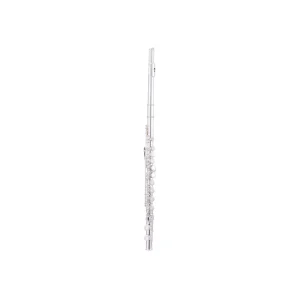I.The Hardest Wind Instrument to Play: The Oboe

Why is it difficult?
- 1.Reed crafting and control:
The oboe uses a double reed made from two pieces of cane, which players must often trim themselves or purchase as custom-made. The thickness, moisture level, and tip opening of the reed directly affect tone and intonation. Beginners struggle to control lip pressure—too tight causes no sound, too loose leads to airy tone. Reed maintenance is also demanding (must be kept moist and is easily damaged). - 2.Extremely sensitive intonation:
With a conical bore and irregular tone hole spacing, the oboe’s pitch is highly sensitive to subtle changes in breath pressure and finger position. Even slight variations in embouchure or airflow can cause noticeable pitch deviations. Since the oboe often sets the standard tuning (A) in orchestras, precision in intonation is critical—making ensemble playing difficult for beginners. - 3.Complex technique and demanding tone quality:
Playing requires coordinated control of breath, embouchure, and fingering. Performing legato and staccato passages demands strong lip muscle control. The tone should be clear and nasal yet round—avoiding sharpness or dullness—requiring long-term refinement by new learners.
Main feature:
The oboe has a clear, nasal tone with a pastoral or melancholic quality. It’s often used for solos and lyrical lines in orchestral music (e.g., Dvořák’s New World Symphony, “Going Home” theme), making it a highly recognizable melodic instrument.
II. The Easiest Wind Instrument to Play: The Recorder
Why is it easy?
- 1.Simple structure and easy handling:
The recorder has a straight body with 6–8 tone holes (Baroque recorders typically have 6). Fingering is regular and open-holed with no complex keys. Beginners can quickly play simple melodies by learning basic hand positions and a few core notes. - 2.Low barrier to sound production:
The recorder uses a “fipple” mouthpiece with a fixed air channel, requiring no lip vibration. Players simply blow steadily into the mouthpiece to produce sound—making it almost “sound on the first try” for beginners. - 3.Narrow range and stable intonation:
A typical eight-hole recorder has a range of about two octaves. Tone holes are evenly spaced, and the air channel design stabilizes airflow, making pitch less affected by breath control issues—a common beginner struggle.
Main feature:
The recorder has a pure, soft tone resembling a child’s voice. It is ideal for music education and classical miniatures (e.g., Baroque recorder concertos by Vivaldi). Due to its low entry barrier, it’s widely used in music education as a starter instrument.
III. Key Differences Between the Oboe and Recorder
| Comparison Dimension | Oboe | Recorder |
| Sound Production | Lip vibration through a double reed | Airflow through fixed fipple mouthpiece |
| Difficulty Level | Very high (reed, intonation, technical skill) | Very low (simple structure, stable pitch) |
| Tone Quality | Clear, nasal, slightly melancholic | Pure, bright, flute-like |
| Orchestral Role | Melodic lead, often used for solos and tuning | Mostly for education or light music, rarely in orchestras |
| Material & Structure | Wooden body (usually African blackwood), metal keys | Plastic or wood body, no complex keys, open holes |
IV. Foundational Concepts Explained
1.Timbre (Tone Color):
- Definition: The “character” or “quality” of a sound, determined by material, structure, and vibration method. Different instruments playing the same note still sound different due to timbre.
- Example: The trumpet sounds bright and piercing, the flute sounds crisp and airy, and the oboe has a nasal tone—these differences are all timbral.
2.Pitch:
- Definition: The perceived highness or lowness of a sound, determined by the frequency of vibration (higher frequency = higher pitch).
- Example: The high C on a piano vibrates faster than the low C, making it sound “sharper.”
3.Intonation:
- Definition: The accuracy of pitch during playing or singing—whether you’re in tune with the written note.
- Example: A trumpet played with too much air may sound sharp; a trombone slide positioned too far may cause flatness.
4.Scale:
- Definition: A series of notes ordered by pitch, usually starting and ending on the same note an octave apart, following whole- and half-step patterns.
- Example: The C major scale is C–D–E–F–G–A–B–C, the most basic natural major scale.
5.Melody:
- Definition: A sequence of notes with rhythm and pitch that form a musical line—one of the core expressive components in music.
- Example: The tune of “Happy Birthday” is a simple and familiar melody made up of varying notes and rhythm.
Резюме
The core difference between the hardest and easiest wind instruments lies in their sound production mechanisms and technical thresholds. The oboe requires mastery over delicate reed control and precise breath coordination—ideal for those pursuing professional musicianship. In contrast, the recorder’s minimalistic design makes it the perfect entry-level choice for beginners.
Understanding musical concepts like timbre, pitch, and melody is fundamental for mastering any instrument—they are the “building blocks” of musical expression.
We are a professional manufacturer of musical instruments,selling a variety of high-quality musical instruments,such as flutes, saxophones, etc. If you want to know more about wind instruments, please contact us!







